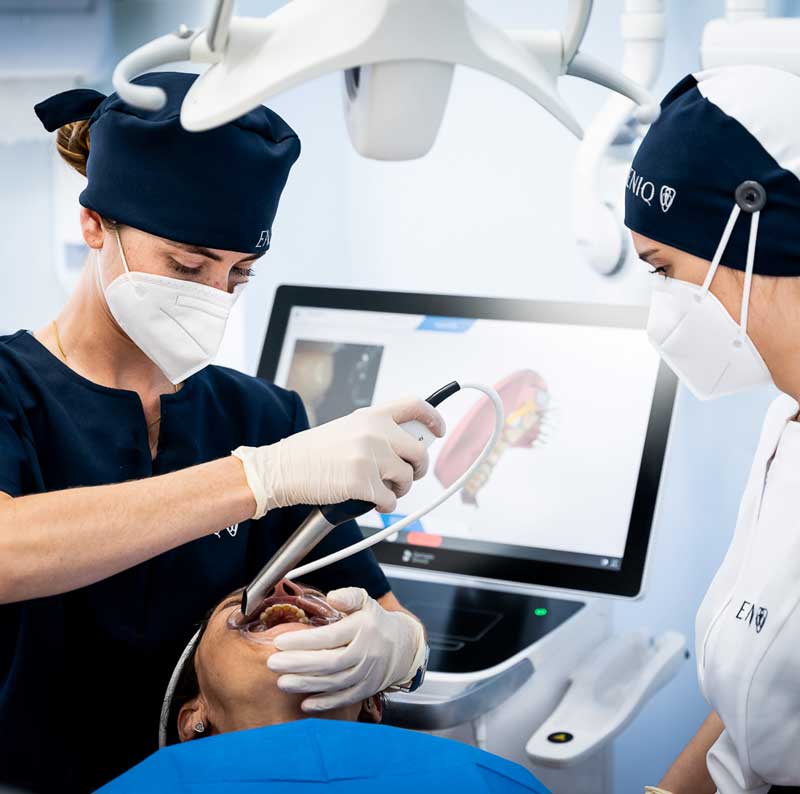

Brackets
Specialists in braces to align your smile.
What Are Dental Braces?
Dental braces are devices used in orthodontics to correct the position of teeth and achieve proper dental alignment. They are small metal, ceramic, or plastic pieces that are attached to the surface of the teeth with the aim of applying pressure and gradually moving them to the desired position.
Braces are designed to work in conjunction with other components of orthodontic treatment, such as archwires and elastic ligatures. Archwires are inserted into the brackets and apply pressure, while elastic ligatures are used to hold the archwire in place. As the archwire exerts pressure on the teeth, they gradually shift and align.
What Types of Braces Are There?
There are different types of dental braces based on the material, including:
- Metal Braces: These are the most common and are made of stainless steel. They are durable and effective but can be more visible due to their metallic color.
- Ceramic Braces: They are made of ceramic or porcelain materials that resemble the color of teeth, making them less noticeable. They are a popular choice for those who want their braces to be less conspicuous.
- Sapphire Braces: These are similar to ceramic braces but are made of clear sapphire crystal. They are highly aesthetic and blend with the natural color of teeth.
- Plastic Braces: These are less common and are made of transparent plastic materials. They are more aesthetic than metal braces but may not be as durable.
The type of braces used will depend on the patient's needs and preferences, as well as the orthodontist's recommendation. Dental braces require special care during orthodontic treatment, such as good oral hygiene and avoiding certain foods that can damage them.
Duration
How Many Appointments Are Needed During Self-Ligating Braces Treatment?
The frequency of appointments for self-ligating braces treatment varies by patient but is usually less frequent than with traditional braces because they don't require changes in elastic or metal ligatures. Adjustment appointments are typically spaced every 6 to 8 weeks. The duration and number of visits to the orthodontist will depend on the complexity of the case and the response to treatment.

- Less Friction: Self-ligating braces eliminate elastic ligatures, reducing friction and potentially allowing for smoother and less discomforting tooth movements.
- Fewer Orthodontist Visits: The absence of elastic ligature adjustments means that fewer maintenance visits are typically needed.
- Shorter Treatment Time: Some studies suggest that self-ligating braces may shorten the total treatment time compared to traditional braces.
It's crucial to remember that the effectiveness of self-ligating or conventional braces depends on the uniqueness of each case and the care provided by a qualified orthodontist. The decision between using self-ligating or conventional braces should be based on the specific needs of the patient and professional recommendations.

What Types of Braces Exist?
What Are Damon Braces?
The term "Damon braces" refers to Damon self-ligating braces, which are a specific type of self-ligating braces used in orthodontics. They are characterized by their patented design and technology.
The main difference of Damon self-ligating braces compared to other self-ligating braces is their closure mechanism. They use a sliding door or passive clip to hold the dental arch in place, eliminating the need for elastic or metal ligatures.
These brackets are designed to allow for freer and smoother dental movement, reducing friction and possibly resulting in a more comfortable and efficient treatment. This can translate into fewer adjustment appointments needed compared to conventional braces.
Additionally, Damon self-ligating brackets are known for their low profile and smoothed edges, which can provide greater comfort to the patient and reduce irritation to oral tissues.
It's important to note that Damon self-ligating brackets are a specific trademark, and they may be available in different materials and design options. It's essential for a qualified orthodontist to assess if they are suitable for your specific case.
What Are Lingual Braces?
Lingual braces are an orthodontic treatment option in which the brackets are placed on the backside of the teeth, facing the tongue. Unlike traditional braces that are placed on the front of the teeth, lingual braces are virtually invisible from the front.
Lingual brackets adhere to the inner surface of the teeth and are custom-designed to fit the shape and contour of the patient's teeth. They are made from metallic or ceramic materials and function similarly to traditional brackets, using archwires and elastic ligatures to apply pressure and move the teeth into their correct positions.
Some advantages of lingual braces include:
- Aesthetics: Placed on the backside of the teeth, lingual braces are virtually invisible from the front, making them appealing to those seeking a discreet option for dental correction.
- Lingual Comfort: While they may require an adjustment period and cause discomfort initially, many patients adapt to lingual braces over time.
- Precise Control: Lingual braces offer detailed control over tooth movement, which can lead to more efficient and effective treatment.
It's important to note that lingual braces may require greater skill and expertise on the part of the orthodontist compared to traditional braces. Additionally, the cost of lingual braces treatment is usually higher. Each orthodontic case is unique, and the choice between lingual braces and other types of braces will depend on the patient's specific needs.
What Are Esthetic Braces?
Esthetic braces are an orthodontic treatment option used to correct tooth alignment similar to traditional metal braces. The main difference lies in their more aesthetic and discreet appearance.
Esthetic braces are designed to be less visible compared to metal braces. They are made from translucent or tooth-colored materials, making them less noticeable. Some of the most common materials used for esthetic braces include ceramic, polycarbonate, and sapphire.
- Ceramic Braces: Made from ceramic material and are tooth-colored. They are popular for their discreet appearance.
- Polycarbonate Braces: Made from transparent plastic material. They are less visible than metal braces but may be less durable.
- Sapphire Braces: Made from clear sapphire crystal, which is highly durable and resembles tooth enamel. They are highly aesthetic and nearly invisible.
Esthetic braces function similarly to traditional braces, using archwires and elastic ligatures to apply pressure and move the teeth into their correct positions. However, esthetic braces may require slightly different care and maintenance to preserve their aesthetic appearance.
It's important to note that esthetic braces can be more fragile and prone to staining compared to metal braces. Therefore, it's necessary to follow care instructions and maintain good oral hygiene to prevent discoloration or damage to the braces.
The choice between esthetic braces and metal braces will depend on the patient's needs and preferences, as well as the orthodontist's recommendation. The orthodontist will evaluate your case and help you select the bracket option that best suits your aesthetic and treatment needs.
+90%
What is the effectiveness of self-ligating braces in orthodontic treatments?
The success of treatment with self-ligating braces depends on factors such as the severity of malocclusion, patient cooperation, and the skill of the orthodontist. Although there is no fixed percentage of success, clinical studies have shown that they have similar success rates to conventional braces in terms of dental alignment and bite correction.
Patient collaboration is crucial for success, including brace care and good oral hygiene. The success rate varies by individual, so consulting with a qualified orthodontist for a personalized evaluation is important.
Benefits of self-ligating braces treatment at ENIQ
The treatment with self-ligating braces at ENIQ benefits from our advanced 3D digitization technology, which allows for greater precision and predictability in orthodontic results. Unlike conventional brace treatments that can last up to 4 years, the average treatment time for self-ligating braces at ENIQ is reduced to just 18 months, with more affordable payments and results aligned with 3D planning.
What is the cost of dental braces?
We offer financing options without documentation ranging from 150€ to 3000€ that cover this type of treatment.
Metal Braces
Affordable
*subject to specialist evaluation
Orthodontic treatment with metal braces is the most affordable option currently available. In Spain, prices vary between 2,300 and 3,200 euros, although these values are indicative and depend on the complexity and duration of the treatment.
-
All-inclusive
Sapphire Braces
Aesthetic
*subject to specialist evaluation
Sapphire braces, being more aesthetic, have a higher cost than conventional metal braces. Prices for this type of orthodontics range from 3,000 to 4,200 euros.
-
All-inclusive
Damon Braces
Innovative
*subject to specialist evaluation
The cost of orthodontic treatment with Damon braces is similar to that of sapphire braces, ranging from 3,000 to 4,600 euros. This variation is due to the options available within Damon orthodontics, which include both metal and transparent braces.
-
All-inclusive
Frequently Asked Questions
Do you have any other questions about braces?
According to the SEDO (Spanish Society of Orthodontics), it is recommended that children have their initial orthodontic evaluation at the age of six, coinciding with the eruption of their first permanent molars.
This stage is ideal because the dentition and bone structure are still developing, allowing for a simpler and more effective intervention for potential dental formation anomalies compared to interventions in adulthood.
The orthodontic specialist will be the one to determine the precise time to start orthodontic treatment in children after systematic evaluations.
No, not all braces require the use of elastic ligatures or "bands." Conventional braces use elastic ligatures to hold the archwire to the bracket. These elastic ligatures are small bands that fit around the bracket and archwire.
However, self-ligating braces are an alternative in orthodontics that do not require the use of elastic ligatures. These braces have a built-in closure mechanism that holds the archwire in place without the need for external ligatures. Self-ligating braces can have a sliding door mechanism or a closing clip that keeps the archwire in position.
Self-ligating braces offer advantages such as less friction, greater comfort, and fewer adjustment visits compared to conventional braces. They can also facilitate better oral hygiene as they do not have bands that can trap food or hinder cleaning.
It is important to note that each orthodontic case is unique, and the choice between conventional and self-ligating braces will depend on individual needs and preferences, as well as the orthodontist's recommendation.
It is crucial to be selective with your diet when you have braces. It is recommended to avoid excessively hard foods, such as nuts or crunchy snacks, as well as sticky foods like chewing gum or chewy candies to prevent damage to the braces.
Specifically, two categories of food should be avoided: hard foods (such as popcorn or hard beans) and sticky foods (such as gum or sticky toffees). Hard foods can cause the brackets to detach, while sticky foods can compromise dental hygiene.
Furthermore, it is advisable to avoid biting directly into foods like sandwiches or hard fruits. These can exert force that may result in bracket detachment or damage.
Services
All rights reserved © ENIQ Clinic 2025
Legal Notice · Privacy Policy · Cookie Policy
